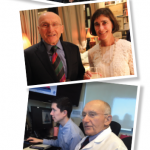“We are building a national network of physician specialists in rheumatology, hematology, cardiology, endocrinology and gastroenterology, who can remotely provide medical services to underserved populations,” Dr. Green says.
In addition to providing specialist care to community health clinics, Dr. Green says MAVEN also provides a volunteer and social outlet for rheumatologists who want to continue providing patient care without handling the business side of medicine.
“Doctors work in large student cohorts as they progress through medical school and then work with colleagues throughout their career,” Dr. Green says. “Suddenly in retirement, they become isolated and no longer have that interaction with others who share their medical mindset.”
Dr. Green adds that the staff of MAVEN work hard to make the volunteer experience a seamless one for physicians.
“We facilitate onboarding, cover malpractice insurance for MAVEN-related activities and provide our volunteer physicians with access to HIPAA-secure telehealth technology,” Dr. Green says.
For retired physicians, including Dr. Bernhard, MAVEN provides the opportunity to share their expertise and to help patients who have difficulty accessing rheumatology services.
“MAVEN gives retired physicians the chance to stay involved,” Dr. Bernhard says. “While our country is experiencing a physician shortage, we’re also seeing an increase in the number of people with rheumatic diseases, in part because of the aging baby boomer generation.”
Dr. Einstein notes that MAVEN offers their volunteer physicians flexible hours and the ability to work from their own home or office.
“We’re also creating a physician community where our volunteers can connect with their MAVEN colleagues either online or in person,” Dr. Einstein says. “We recently had a social event that brought together many of our West Coast physician volunteers, and we plan to host similar events in the future.”
Linda Childers is a health writer located in the San Francisco Bay area.
References
- The MAVEN Project.
- New research confirms looming physician shortage: Shortages particularly acute in specialties most needed by an aging population. Association of American Medical Colleges. 2016 Apr 5.
- Deal CL, Hooker R, Harrington T, et al. The United States rheumatology workforce: Supply and demand, 2005–2025. Arthritis Rheumatol. 2007 Mar;56(3):722–729.
- Salaffi F, Carotti M, Ciapetti A, et al. Effectiveness of a telemonitoring intensive strategy in early rheumatoid arthritis: Comparison with the conventional management approach. BMC Musculoskelet Disord. 2016 Apr 2;17:146.



